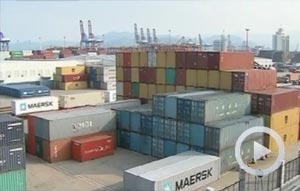Long road for consumption to go
Updated: 2013-07-05 07:21
By Lan Lan (China Daily)
|
||||||||
It will be difficult for consumption to replace investment as a major driving force for China's economy in short to medium term, said a senior economist at a government think tank.
China's high investment growth will continue from 2013-2015, coinciding with a period of slow growth as the economy goes through a cyclical downswing, Ma Xiaohe, deputy director-general of the Academy of Macroeconomic Research under the National Development and Reform Commission, told China Daily.
China's growth has become more reliant on credit-fueled investment in recent years, after exports sustained a blow from the global slowdown that began in 2008.
But it's evident that an increasing contribution of investment to growth has led to problems such as overcapacity and credit bubbles.
There is still "impetus and space" for China to maintain the trend of high investment growth, but the investment structure must be optimized, he said.
Infrastructure and services involving water, roads and electricity in China's villages need to be improved. For instance, more than 300 million rural people are drinking unsafe water, according to official data.

"The role played by investment cannot be totally denied, and China still has great potential to boost public investment," said Ma.
But strict limits should be set on investing in energy-intensive, high-emission industries or building new towns. Investment should be injected into areas that are generally beneficial to lower the costs of public services, he added.
As the government aims to have consumption play a larger role in its investment-led economy, reforms in consumption's favor should be put into place, said Ma.
Decisions for investing can be made by a few people in short period, so it has been frequently used to stimulate the economy during slowdowns or crises.
Purchasing decisions, however, are made by highly fragmented consumers who are restricted by their income levels.
"China's economic growth mechanism and existing policy arrangements are more advantageous to investment than consumption," said Ma.
"An increasing proportion of earnings went to government and enterprises in recent years. Such a distribution pattern is certainly in favor of investment expanding, not consumption," he said.
Household earnings only account for about 50 percent of China's national income, compared with about 68 percent in developing countries and about 75 percent in developed countries, according to Ma.
In addition, the redistribution system is tilting in favor of high-income groups, which also constrains the nation's purchasing power.
One-fifth of China's richest people save about 50 percent of their annual income because their demand for cars and houses have been largely satisfied.
Low-income groups have higher demand but lack purchasing power because they have gained little in redistribution.
China has the world's highest household savings rate, due to a weak social safety network, which keeps savings rates high and consumption low.
Boosting consumption will eventually be up to the reform of China's distribution system. Barriers to consumption should be cleared, he said.
"China has moved from a high-growth era to slowing growth, and the economy will be on the downswing in the coming years. However, reforms and innovations that are being worked on by the new leadership will lay a foundation for growth," he said.
The media has previously reported that the new leadership is working on a package of economic and financial reforms and major decisions are expected to be made at a Party meeting in the autumn.
Reform of the energy and resource-pricing system, the household registration system (hukou) and social security system, as well as reform of State-owned companies' role in competitive industries, should get top priority on the regulators' to-do list, said Ma.
Meanwhile, the investment-led growth model have led to a sharp increase of local government borrowing and added risks to banks by exposing them to local government debt.
Outstanding bank loans to local government financing vehicles totaled 9.59 trillion yuan ($1.55 trillion) at the end of the first quarter, said Shang Fulin, chairman of the China Banking Regulatory Commission, at a recent financial forum.
The risks of local debt need to be watched, but the risks are fragmented at the local level, which is not as serious as the sovereign debt crisis in the eurozone, said Ma.
To ease the fiscal constraints of local governments, the central government needs to further reform its fiscal and tax systems and allow local governments to gain larger financial power, he said.
(China Daily USA 07/05/2013 page18)

 Chinese fleet arrives in Vladivostok for drills
Chinese fleet arrives in Vladivostok for drills
 Joey Chestnut wins 7th contest with 69 dogs
Joey Chestnut wins 7th contest with 69 dogs
 Lisicki, Bartoli to vie for new Wimbledon crown
Lisicki, Bartoli to vie for new Wimbledon crown
 Muscle Beach Independence Day
Muscle Beach Independence Day
 Tough workout for Li Na in war of words
Tough workout for Li Na in war of words
 Submersible taps mineral deposits in S China Sea
Submersible taps mineral deposits in S China Sea
 Ecuador finds spy mic for Assange meeting
Ecuador finds spy mic for Assange meeting
 US martial artists arrive at Shaolin Temple
US martial artists arrive at Shaolin Temple
Most Viewed
Editor's Picks

|

|

|

|

|

|
Today's Top News
Mandela on life support, faces 'impending death'
Missouri govt's veto won't stop Smithfield deal
ROK to discuss Kaesong normalization with DPRK
Gunman shoots two, commits suicide in Texas
Baby formula probe to shake or reshape industry?
Passenger detained over bomb hoax in NE China
High rent to bite foreign firms in China
Egypt's prosecution imposes travel ban on Morsi
US Weekly

|

|






